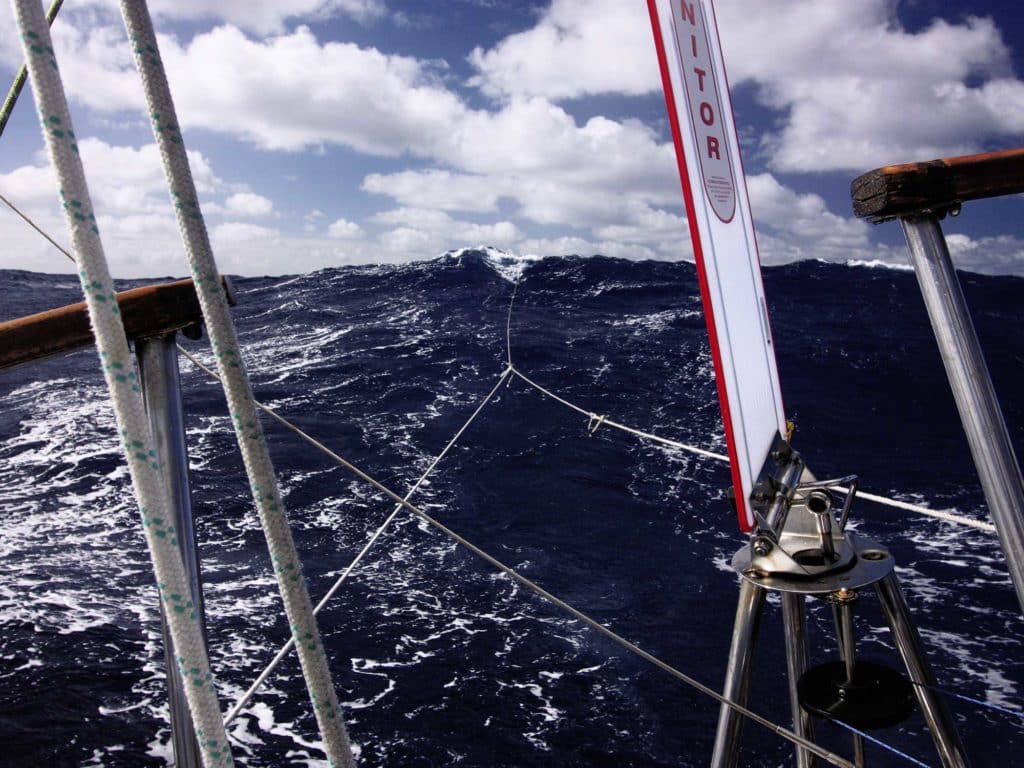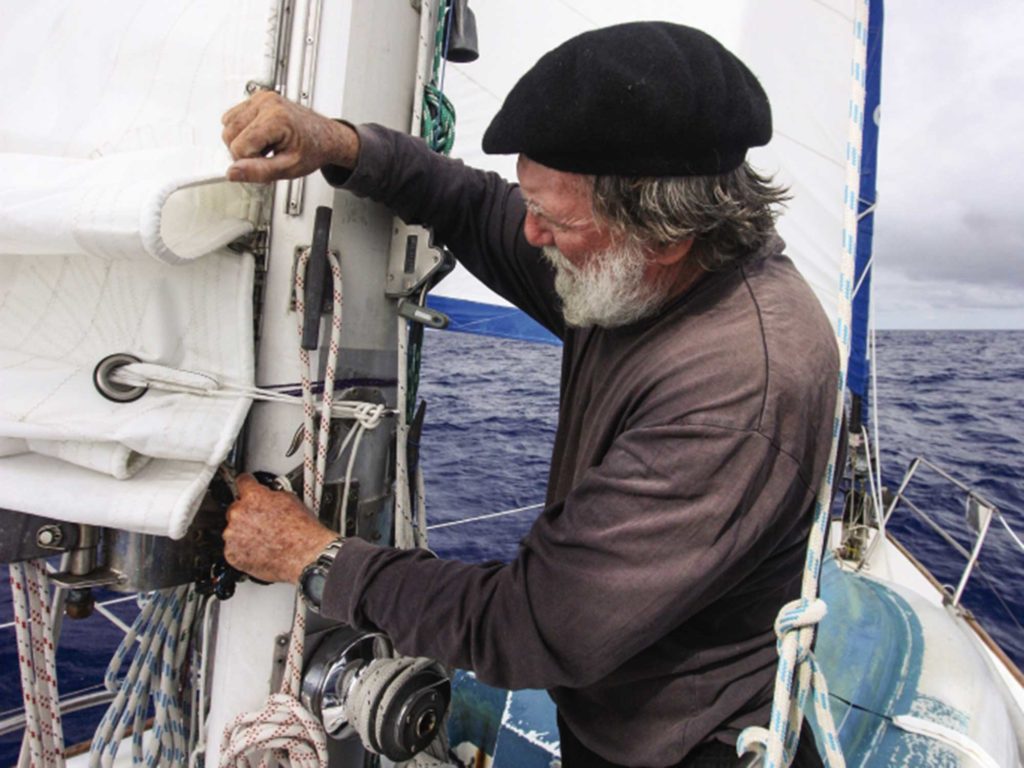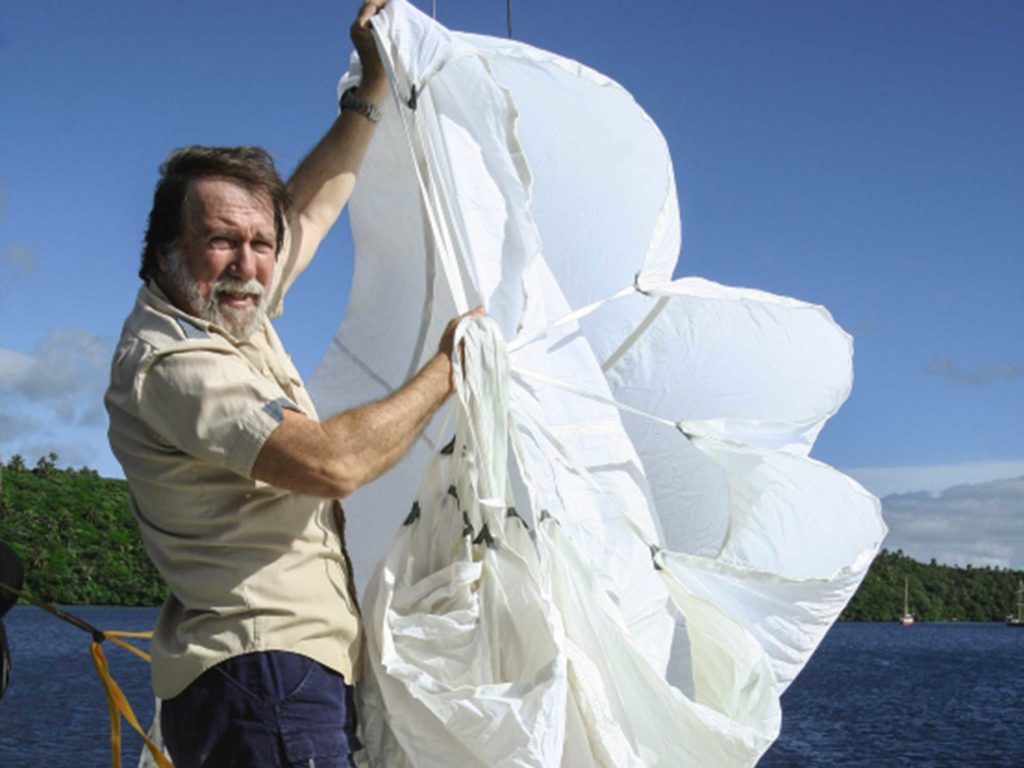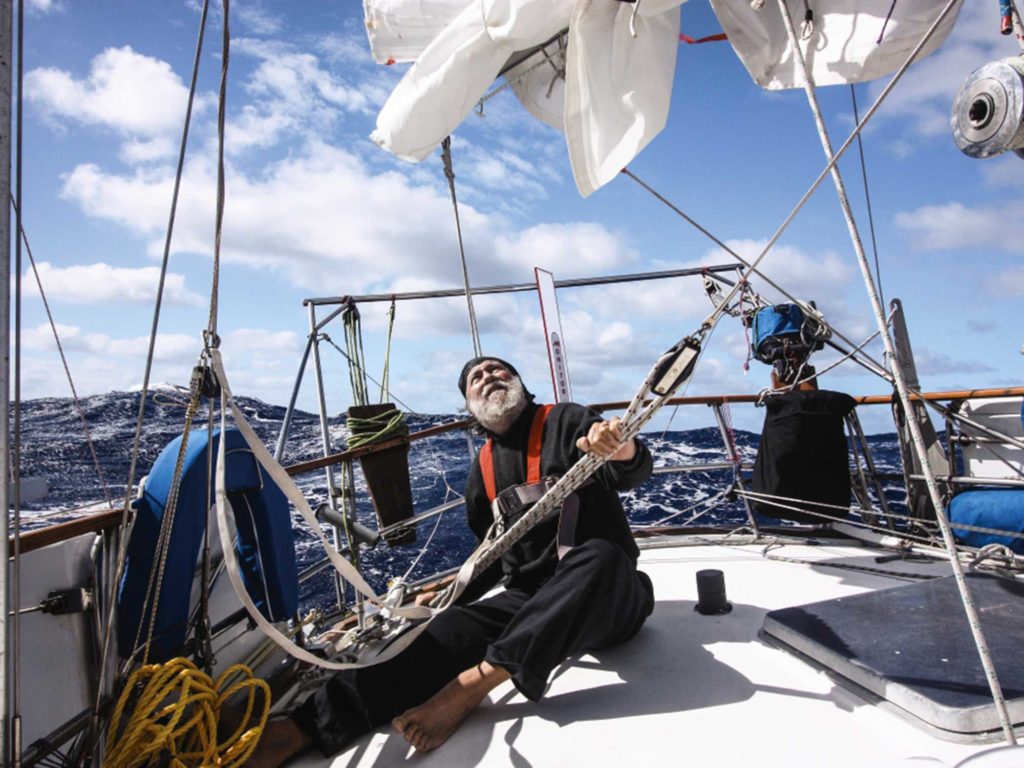
As a clumsy Chicago teenager, I worked at Blatt’s restaurant on Michigan Avenue—the cheese blintzes were to die for. One day Nat, the manager, asked me to replace a fluorescent bulb. I broke the first one attempting to withdraw it from its skinny carton, and I broke the second one while attempting to insert it while standing on the counter. Not good. This gave me a lifelong respect for the fragility of fluorescent tubes.
A few years later, while still a teenager and sailing with my wife-to-be, Carolyn, I came across another fluorescent tube, this one in the Cozumel Channel between Yucatan and Cuba. It was dancing on the face of a giant breaking wave during a full gale.
The unexpected sight of it in such a bizarre, storm-tossed circumstance blew my mind. It seemed impossible that something that fragile could survive such monstrous forces. Thus began my lifelong education in heavy-weather sailing.
Let’s stick with fluorescent tubes for a moment. If you toss one into the sea, it immediately lays sideways to the wind and waves, and rolls. But let’s say you attach a short piece of iron rebar lengthwise to the tube with some rubber bands; now it won’t roll if the waves aren’t too big.
Fine. Most well-designed sailboats with keels will fend for themselves for years if they break loose from their mooring.
However, if the seas build, eventually our fluorescent-tube-with-a-keel will tumble; the weight of its keel alone isn’t sufficient to prevent it from rolling over while beam to the waves. However, if you hold the tube in line with the waves so that the waves aren’t striking on the beam but rather on the bow or stern, immediately the keel can work and the fluorescent tube is in a very stable position, even if the wind and seas increase dramatically. And best of all, the tube doesn’t have to be directly into the wind or away from it; 45 degrees to either side is fine. Only lying broadside to the seas is bad.

That’s it. That’s 90 percent of what we need to know about storm management. The rest is just details.
When Less Is More
If you daysail your boat, chances are you drive an automobile to the marina. If you’re a prudent driver, you won’t do this if the car has no brakes or, say, another malfunction like a stuck gas pedal. It should be the same with sailing: If you can’t reef your boat’s sails—akin to taking your foot off a car’s gas pedal—do not take it offshore or head out when the wind is forecast to blow hard.
Of course, the breeze usually doesn’t go from flat calm to hurricane force in an instant; the wind and seas gradually build. Which brings us to the question of when you should reduce sail. The answer is simple: 10 minutes before it enters your head. That’s right, when you think, Should I reef? you’re already a tad late. Believe me, there is no downside to reefing too early—and plenty of downside in neglecting to do so. Remember: The ability to always have the correct amount of canvas up is what separates the lubber from the experienced seaman.
Reefing early and well is important because when the wind doubles, the force on your boat’s rig quadruples, aka a geometric progression. Let’s say you have a boat that is extremely good in light airs and can move forward in 2 knots of breeze. Let’s call that force on your boat X. In a full gale, the force on your vessel can be over 1,000 times that X. Wow!
A well-found cruising vessel should have no problem surviving offshore if properly reefed—up to gale force. But often, our goal as pleasure boaters isn’t merely to survive, we want to have fun as well. So Carolyn and I usually start thinking about heaving to before the wind reaches gale force, especially if the forecast is poor.
Many sailors come to me and say, “Teach me how to heave to,” and I say, “You already know, you just forgot.”
They look at me like I’m nuts, which is the subject of a whole other article, perhaps for Psychology Today. While learning to sail in moderate conditions, many of us have tacked without uncleating the headsail—yippee! That’s it. That’s heaving to. Your sails sort of cancel each other out, with the mainsail wanting to round the boat up, and the backwinded headsail attempting to force the bow to fall off.
Each boat will heave to differently, so I can’t give you specific advice on what exactly will apply to your vessel. And every skipper will develop a favorite way of doing things. Lin and Larry Pardey, for instance, preferred to heave to with a backwinded jib. I’d rather use the mainsail alone because it’s worked well on all of my other boats. On our present vessel, Ganesh, we have a solent rig, so both headsails are far forward, and both have foam in their luffs (it helps them hold their shape when partially reefed), so they provide plenty of windage, even when completely rolled up in winds over 26 knots.
When we decide it’s time to heave to, I sail into the wind with only a deep-reefed mainsail or storm trysail up, and no headsail. I point closer and closer into the wind while trimming my mainsheet until the boat loses almost all forward motion; she’s just sitting there, hobbyhorsing about 30 degrees into the wind. I secure the mainsheet and tie off the helm, and then I watch. This watching is the key. I simply allow the boat to show me what she wants. As my father used to tell me as I was growing up aboard the 52-foot schooner Elizabeth: “Listen to the boat, son. She’s smarter than you’ll ever be.”
Here’s what happens with the boat’s nose stuck in the wind: She hunts. Her bow falls off, and her small main fills and forces her bow back up again, but not with enough force to make her come about. Hard on the wind, the main luffs, the bow falls off, and the cycle repeats itself. This might work for your boat too, or maybe you’ll benefit from rolling out a little “jib tongue” to help blow the bow down.
Once I get the boat hunting, I play with my four primary mainsail controls: helm, mainsheet, traveler and topping lift. A word about the latter: During a prolonged gale, the topping lift should always be set up to take most of the load, otherwise you can pull the headboard out of your triple-reefed main or bend your mast track if you’re using a storm trysail.

Anyway, I usually tie down the helm—meaning my rudder is attempting to turn the vessel into the wind—and use the traveler to hoist my boom toward the centerline of the boat, and occasionally even over the centerline. The idea is to eliminate all forward motion, to reduce my vessel’s speed to zero.
Then I have Carolyn flush some toilet paper down our Jabsco head.
Huh?
The toilet paper just beneath the surface of the water is easy to see, even with a flashlight at night. If it is moving aft, the boat is forereaching. If it appears that the toilet paper is being magically sucked directly to windward, the sailboat’s perfect. We’re hove to.
If we have a guest aboard, they invariably say at this point, “The wind seems to be abating, right?”
Wrong. We’re merely in our own slick. Our vessel is moving sideways, and its semifull keel is roiling the water and causing the seas to break fore and aft of us but not upon us.
It’s the closest thing to a magic trick I know.
Even in a major blow, Carolyn makes bread and I write; I won’t even mention renewing our marriage vows.
Of course, we still maintain a watch at 10- to 15-minute intervals; the boat is well-lit, our AIS transponder is on, and we watch our radar screen as well. However, we’re often good without further adjustments for many days, and in winds up to 50 knots or so, which is extremely rare.
Have a Plan B
At this point, we’re perfectly safe unless something breaks, which, of course, can happen.
It is possible—but not probable—that our halyard, mainsheet, topping lift or traveler might fail. If it does and the seas are in the 25- to 30-foot range, we have to act quickly. This is why, in storms, the Pardeys often decided not only to heave to, but they deployed a sea anchor as well. We don’t do this because 1) our boat is far bigger and heavier than theirs; and 2) because retrieving our Paratech sea anchor is the most dangerous thing I’ve ever intentionally done in my life.
Twice while hove to something has broken: one time a gooseneck and the other time a tang that held the mainsheet. Both times I had to deal with it immediately; I could not allow the boat to ride sideways to the seas. And so I dashed on deck, clawed down the tiny sail and steered dead downwind.
Remember when I mentioned that keeping the boat from going broadside to the waves is 90 percent of storm management? Well, the other 10 percent is keeping your speed low.

The problem with running off before the wind in truly massive seas isn’t merely being repeatedly pooped by the breaking waves; it’s also the speed to which your vessel accelerates as it slides down the face of each wave.
In heavy seas off Madagascar, our speedo recorded 14 to 16 knots as we slid down the mountainous faces of the large waves caused by wind opposing the current. Yikes!
Luckily, all boats carry numerous slowing devices—even yours.
“No,” you say?
“Yes,” I say. Almost all boats have fenders, for example. And extra sails. And spare anchor rodes. And spare dock lines. All of which can be towed as drogues to slow down your vessel and prevent a pitchpole.
A pitchpole occurs when your vessel gets going so fast down the face of a large wave that she digs her bow into the trough; then the wave tosses her stern upside down over the bow. This is not good. This is bowel-loosening bad.
Luckily, pitchpoling isn’t common. While I know seven sailors who have rolled their vessel, only two think they might have pitchpoled, and both admit they’re not sure.
You Have Options
Heaving to allows the crew to control a sailboat’s angle to the waves and its speed, and, as I’ve said, it is our go-to option. We seldom use any other heavy-weather tool. In fact, we once sailed halfway around the world relying only on this simple and effective tactic.
However, every boat is different. We seldom towed slowing drogues on Wild Card, our Sparkman and Stephens-designed sloop, while we often tow drogues aboard Ganesh, which tends to get squirrelly in large following seas. What’s the difference? I’m really not sure and don’t feel technically qualified to answer that question, save to say Wild Card’s transom was the size of a handkerchief and Ganesh’s stern is so large that I wish it had reef points.
The whole idea here is to have lots of arrows in your quiver. Not only do we have a storm trysail (with its own halyard and dedicated track) and a triple-stitched storm staysail, we also carry a Paratech sea anchor and a Jordan Series Drogue (JSD).
We personally feel that an inexpensive Westsail 32 with the proper gear is much, much safer than a multimillion-dollar yacht that lacks proper storm kit.
Do we think all offshore vessels have to carry storm sails, drogues, Paratechs and JSDs? We do not. I’ve often delivered boats without them. But we personally do have them, and when it comes to safety, actions speak louder than words.
Why carry both a Paratech and JSD? Because they do different things. Our Paratech is almost like anchoring; it keeps our boat’s head to the wind and our drift to a minimum. This is perfect if the storm is fast-moving and there’s a lee shore to avoid. But there are times where a lee shore isn’t a consideration and moving with the storm is a good thing; then our JSD is perfect—and much easier to retrieve.
Here’s the good news—heavy weather is rare. In the 60 years I’ve lived aboard and ocean sailed, I’ve been scared only three times: twice in a major gale with a strong opposing current and once with a headsail I couldn’t get down. Call me a chicken, but going aloft during a mature gale in a bosun’s chair with a knife in my teeth doesn’t appeal.
What’s the trick? Basically all you have to do offshore is control your boat’s angle to the waves and its speed—and have a bit of luck.
Luck?
That’s right, luck. That’s what seasoned sailors pray for as they endlessly prepare to go to sea. And remember, if your vessel is well-managed, it has to be only as strong and watertight as a fluorescent tube to survive.
Among his other published titles, Cap’n Fatty Goodlander is the author of Storm Proofing Your Boat, Gear, and Crew, available online.








